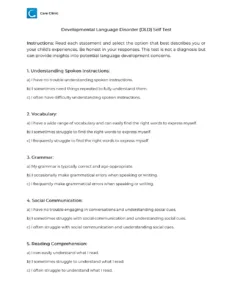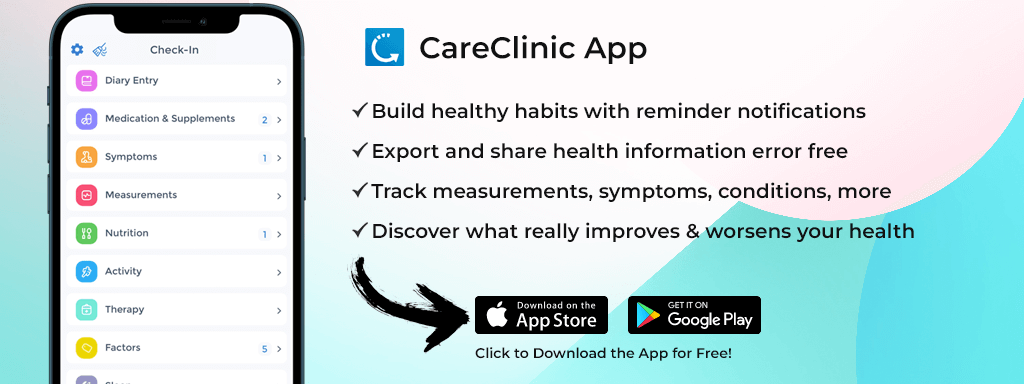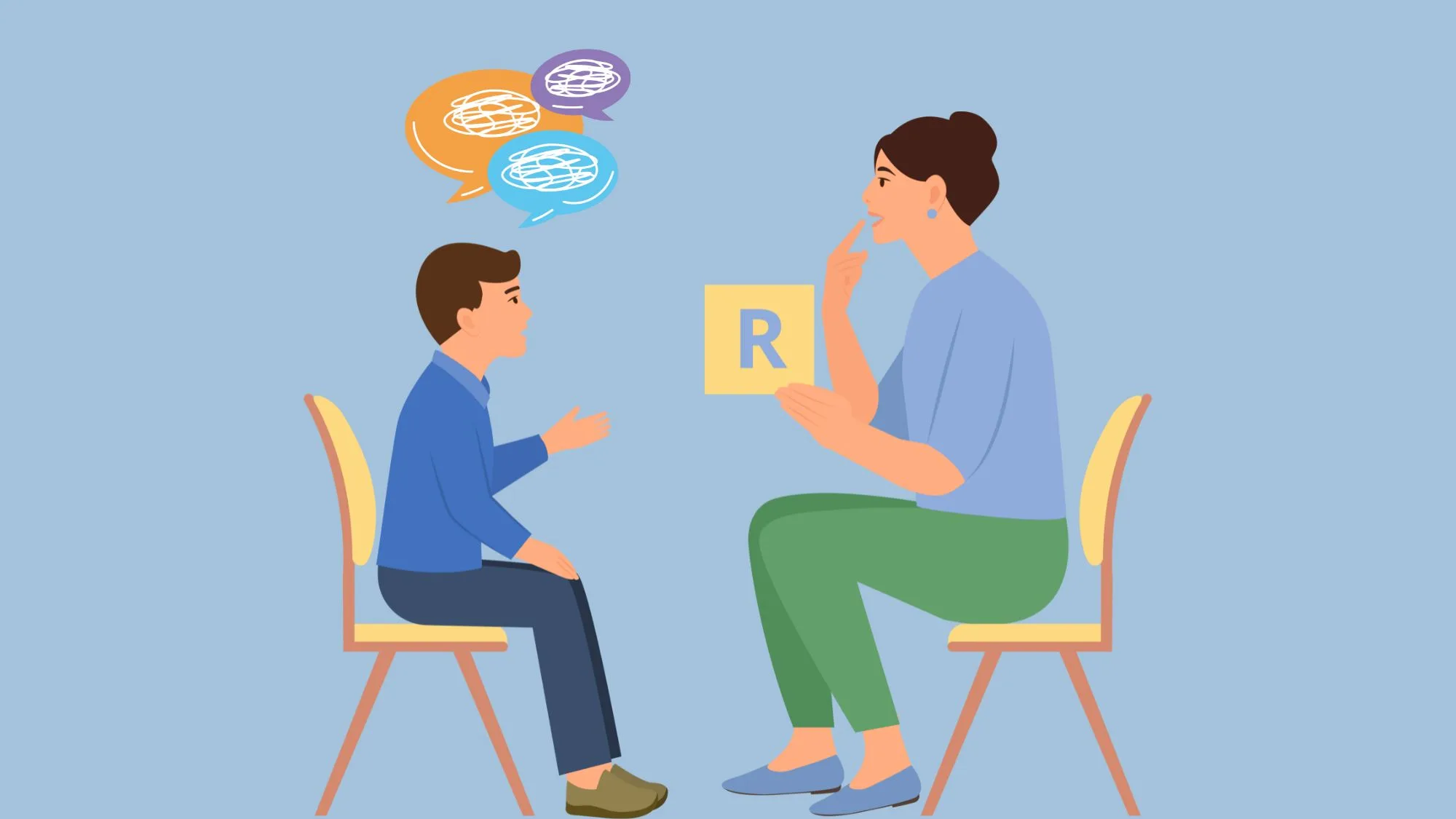
Developmental Language Disorder (DLD) is a condition that affects a child’s ability to understand and use language effectively. It can impact their overall communication skills, academic performance, and social interactions. If you suspect that your child may have DLD, it is important to seek proper assessment and support. In this comprehensive guide, we will delve into the various aspects of the developmental language disorder test, its interpretation, and the available treatment and support strategies.
Printable Standardized Tests for Language Processing Disorders
⬇️ Developmental Language Disorder Test PDF Printable
Understanding Developmental Language Disorder: Definition and Symptoms
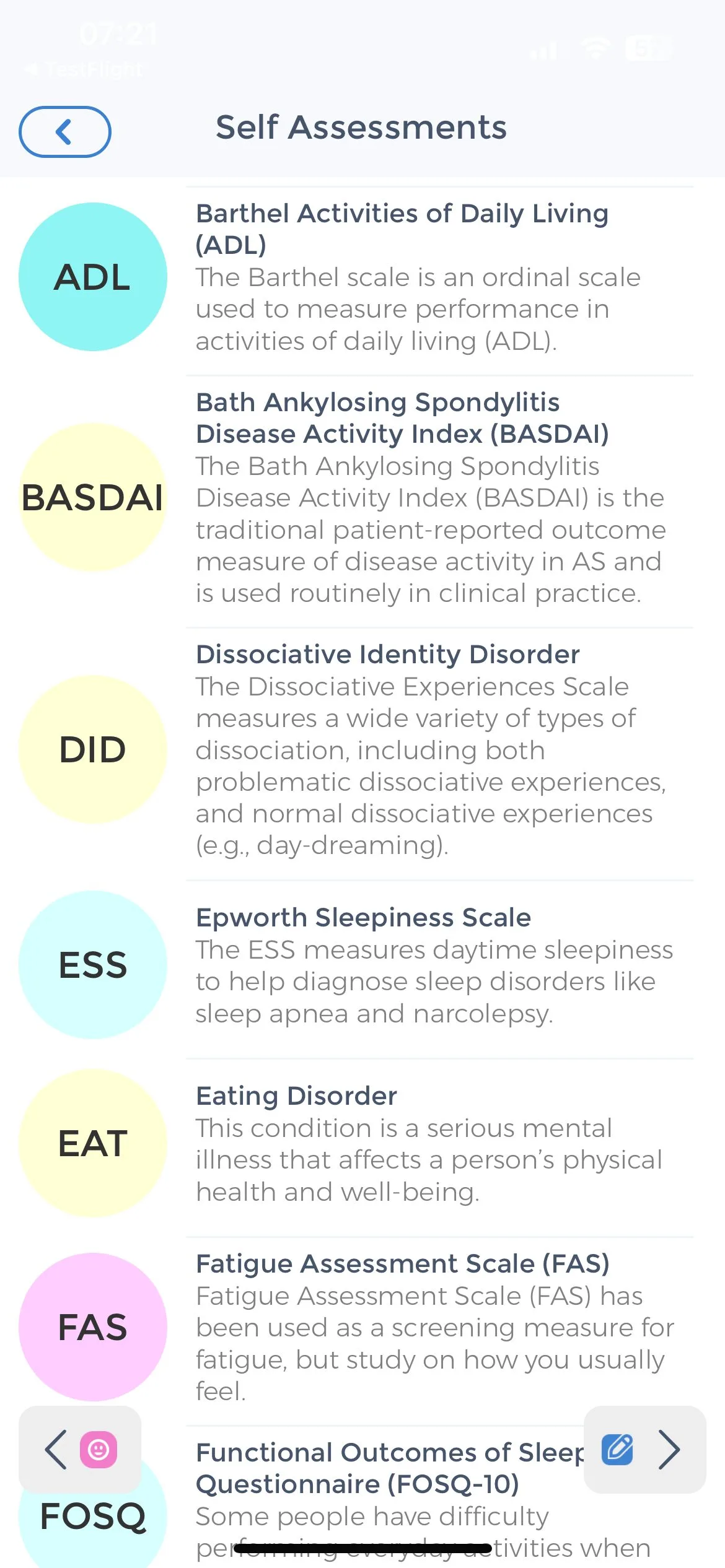 Developmental Language Disorder is a complex neurodevelopmental condition that typically emerges during childhood. Impacting a child’s ability to effectively communicate. It encompasses a range of difficulties in both receptive language (the ability to understand spoken language) and expressive language (the ability to convey thoughts and ideas through speech). Children diagnosed with DLD often struggle with comprehending instructions, engaging in conversations, constructing grammatically correct sentences, and utilizing an appropriate vocabulary.
Developmental Language Disorder is a complex neurodevelopmental condition that typically emerges during childhood. Impacting a child’s ability to effectively communicate. It encompasses a range of difficulties in both receptive language (the ability to understand spoken language) and expressive language (the ability to convey thoughts and ideas through speech). Children diagnosed with DLD often struggle with comprehending instructions, engaging in conversations, constructing grammatically correct sentences, and utilizing an appropriate vocabulary.
Individuals with DLD may exhibit a variety of symptoms, such as:
- Delayed languages spoken and learning disability. Where they may reach linguistic milestones later than their peers.
- Difficulty understanding complex sentences.It’s important to note that language difficulties can sometimes co-occur with or be mistaken for other developmental conditions. For instance, children who struggle with social communication may benefit from professional analysis that examines patterns of social avoidance or interaction challenges. These assessments help differentiate between primary language disorders and conditions where communication difficulties are secondary to social or emotional factors. Leading to challenges in following detailed instructions or narratives.
- Underdeveloped vocabulary skills. Resulting in limited word choices and expressions.
- Struggles with grammar and speech disorders.Making it challenging to form coherent sentences.
Moreover, the impact of DLD extends beyond linguistic difficulties, often affecting social interactions, academic performance, and emotional well-being.
Children with language challenges often feel anxious about speaking or being understood. This anxiety can cause physical symptoms like muscle tension or sudden body movements. Understanding the early signs of tourette’s can help you tell the difference between anxiety-related movements and other conditions.
ttps://careclinic.io/body-jerks-due-to-anxiety/”>anxiety jerks definition helps parents recognize when their child’s physical reactions might be linked to communication stress.
Causes and Risk Factors of Developmental Language Disorder
While the precise etiology of Developmental Language Disorder remains a subject of ongoing research, it is widely acknowledged to stem from a complex interplay of genetic predispositions and environmental influences. Genetic factors, including inherited traits related to language processing, may predispose individuals to DLD.
Additionally, environmental risk factors can contribute to the development of this disorder. Such as a family history of language impairments, premature birth, low birth weight, and prenatal exposure to toxins or substances that can impact neurological development. Understanding the multifaceted nature of DLD causation is crucial in developing effective intervention strategies and support systems for individuals grappling with this communication disorder.
The Importance of Early Detection: Impact on Child Learning
DLD can significantly impact a child’s ability to learn and succeed academically. Difficulties in language comprehension and expression can affect their understanding of subject matter, reading skills and written language, and writing abilities. Early identification and intervention can help mitigate these challenges and provide appropriate support.
Moreover, children with DLD may also struggle with following complex instructions, organizing their thoughts coherently, and engaging in meaningful classroom discussions. These difficulties can hinder their overall academic performance and confidence in their abilities. Early detection of DLD allows for tailored interventions that can address these specific learning challenges and help students reach their full potential.
Social and Emotional Consequences of Late Diagnosis
A late diagnosis of DLD can have far-reaching social and emotional consequences for a child. Difficulties in communication can lead to feelings of frustration, isolation, and low self-esteem. Identifying and addressing the issue early can help foster positive social interactions and emotional well-being.
Additionally, children with undiagnosed DLD may struggle to make friends, participate in group activities, and express their thoughts and feelings effectively. This can result in feelings of loneliness, anxiety, and a sense of being misunderstood by peers and teachers. By detecting DLD early on, educators and parents can implement strategies to support the child’s social development and emotional resilience, creating a more inclusive and supportive environment for their growth.
Components of the Developmental Language Disorder Test
Cognitive Assessment in Developmental Language Disorder Test
A comprehensive evaluation of Developmental Language Disorder (DLD) goes beyond just assessing language skills. It also includes a cognitive assessment to gain a deeper understanding of the child’s overall cognitive abilities. This assessment often involves a series of tests that evaluate the child’s problem-solving skills, memory retention, attention span, and reasoning abilities. By examining these cognitive functions, clinicians can better tailor interventions to support the child’s specific needs.
Speech and Language Evaluation
One of the cornerstone components of the developmental language disorder test is the speech and language evaluation. This evaluation delves into various aspects of language. Including vocabulary, grammar, fluency, and comprehension. By thoroughly assessing these language domains, clinicians can pinpoint the areas where the child is struggling and develop targeted intervention strategies to enhance their communication skills.
Behavioral and Social Interaction Assessment
Understanding the behavioral and social interaction challenges associated with Developmental Language Disorder (DLD) is crucial for developing a comprehensive treatment plan. The assessment of behavioral and social interaction aspects involves examining how DLD impacts the child’s social skills, behavior, and overall functioning across different environments. This evaluation may encompass direct observations and structured interviews with caregivers and teachers. As well as the utilization of questionnaires and rating scales to gather comprehensive information.
Interpreting the Results of the Test
The results of the developmental language disorder test are typically presented in a scoring system that compares the child’s language skills to age-matched norms. These scores help interpret the severity of the language disorder and guide treatment planning.
Each score on the test corresponds to a specific aspect of language development, such as vocabulary, grammar, or comprehension. By analyzing these scores in detail, professionals can pinpoint the areas where the child may be struggling and tailor interventions accordingly.
What Do the Results Mean?
Interpreting the results of the test requires expertise from a qualified professional, such as a speech-language pathologist or a psychologist. They will analyze the results and provide a comprehensive understanding of the child’s language abilities and areas of difficulty. The results will guide the development of an individualized treatment plan tailored to the child’s specific needs.
Furthermore, the results of the test can also shed light on the potential underlying causes of the language disorder. Factors such as hearing impairment, cognitive delays, or environmental influences may be identified through a thorough analysis of the test results. Understanding these underlying factors is crucial in developing a holistic treatment approach that addresses the root causes of the language difficulties.
Therapeutic Interventions for Language Disorders
Treatment for DLD typically involves a combination of individualized therapy sessions, group interventions, and parental involvement. Therapy may focus on improving language skills such as vocabulary, grammar, sentence structure, and social communication. Speech-language pathologists often utilize evidence-based practices. Such as language stimulation techniques, visual supports, and augmentative communication tools, to support language development.
Educational Support and Accommodations
Children with DLD may benefit from educational support in the form of accommodations and modifications to their learning environment. Individualized Education Programs (IEPs) and 504 plans can be developed to provide students with the necessary accommodations. Such as extended time for assignments or exams, preferential seating, and access to assistive technology.
Home Strategies for Supporting Language Development
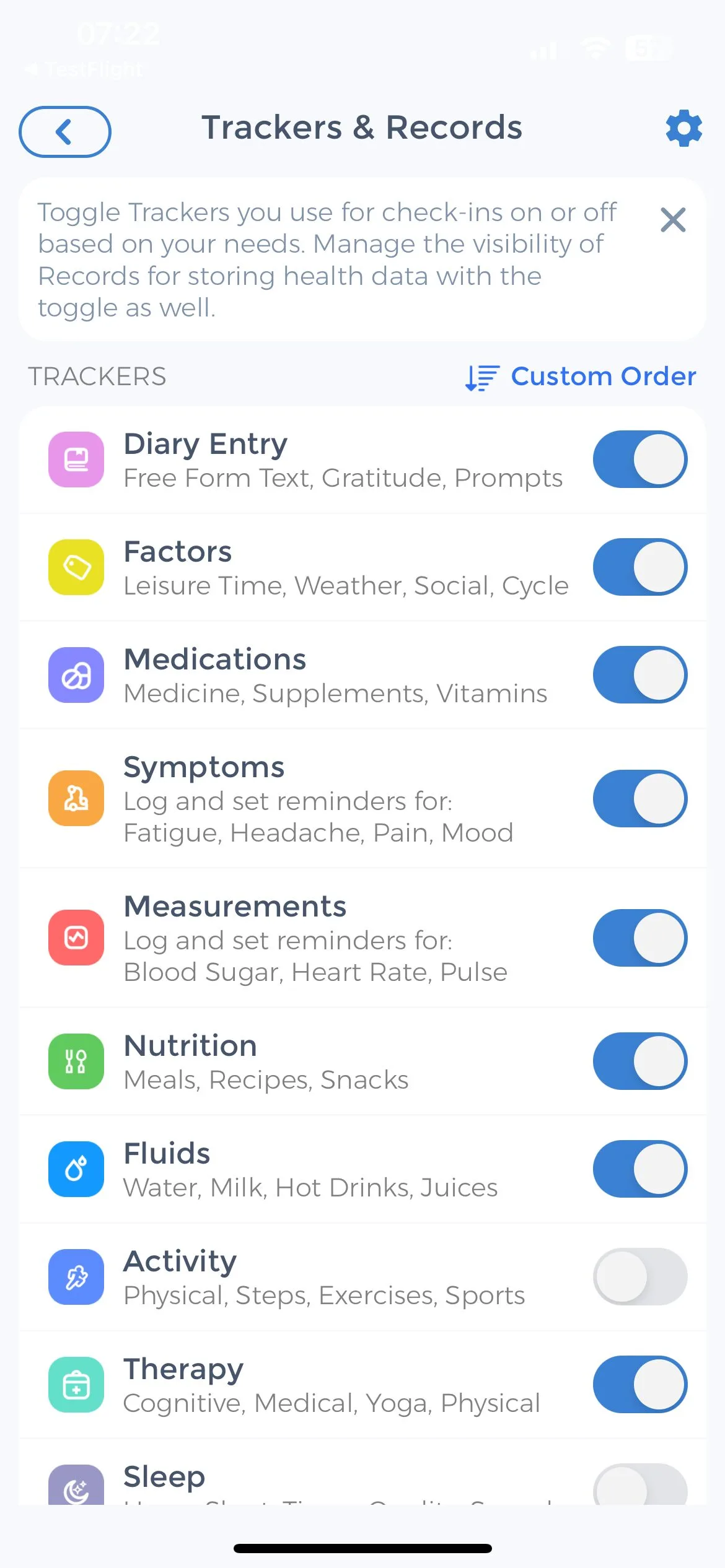 Parents play a crucial role in supporting their child’s language development at home. Creating a language-rich environment through activities such as reading books, engaging in conversations, and playing language-based games can contribute to language growth. Additionally, using the CareClinic App can provide a structured platform to track therapy progress, set reminders for therapy sessions, and access resources for home-based interventions.
Parents play a crucial role in supporting their child’s language development at home. Creating a language-rich environment through activities such as reading books, engaging in conversations, and playing language-based games can contribute to language growth. Additionally, using the CareClinic App can provide a structured platform to track therapy progress, set reminders for therapy sessions, and access resources for home-based interventions.
Furthermore, it is important to note that therapy sessions for DLD can be tailored to the specific needs and interests of the child. For example, if a child has a particular interest in animals, the therapist may incorporate animal-themed activities into the sessions to engage the child and make the learning experience more enjoyable. This personalized approach not only enhances the child’s motivation but also facilitates their language development in a meaningful way.
In addition to therapy sessions, group interventions can also be beneficial for children with DLD. Group therapy provides opportunities for social interaction and peer support, which can help improve social communication skills. Through activities such as group discussions, role-playing, and collaborative projects, children with DLD can practice their language skills in a supportive and inclusive environment.
Treatment and Support Strategies for Developmental Language Disorder
Moreover, parental involvement is crucial in ensuring the success of the treatment and support strategies for DLD. Parents can actively participate in therapy sessions, observe and learn from the therapist’s techniques, and implement them at home. This collaboration between parents and therapists creates a consistent and reinforcing language-learning environment for the child, maximizing their progress and overall language development.
The developmental language disorder test is a vital tool in identifying and understanding the specific language difficulties that a child may be experiencing. Early detection and appropriate interventions can significantly improve a child’s language skills, academic performance, and overall well-being. By utilizing various components of the test, interpreting the results, and implementing targeted treatment strategies, children with DLD can make meaningful progress in their language therapy journey. Remember, with the right support and care, children with DLD can thrive and reach their full potential.
FAQs for Developmental Language Disorders
How do you test for developmental language disorder?
Testing for Developmental Language Disorder can be done by having a patient repeat sentences or obey verbal directions regardless of age. Such tests are beneficial in identifying language difficulties related to this disorder, from children all the way to adults.
What are the signs of developmental language disorder?
Signs of language disorder in terms of development can be noticed through having trouble understanding and using words, expressing oneself with difficulty when speaking, not being able to carry out directions properly, or by delayed reading and writing abilities. There is also usually an issue retaining vocabulary as well as poor articulation skills.
What is the difference between APD and LPD?
In order to differentiate between APD and LPD, which are related respectively to auditory processing difficulties and language issues, a diagnosis by an experienced specialist is necessary for creating the right treatment. Examining carefully any struggles with hearing or communication must be done in order to set up the most effective plan of action.
At what age is language processing disorder diagnosed?
Children aged 3-5 are often diagnosed with Developmental Language Disorder. Late talkers may still receive a diagnosis past the age of three. This type of language disorder usually manifests in developing communication difficulties over time, which can be Examined to give an appropriate diagnosis for each individual child.
What is Developmental Language Disorder (DLD)?
Approximately 7% of the population has difficulty in understanding and using language, leading to a developmental language disorder (DLD). This is a common form of language-related condition which affects comprehension as well as use.
Use the CareClinic App to Manage Diagnose Developmental Language Disorder
Take the next step in supporting your child’s journey with Developmental Language Disorder by incorporating the CareClinic App into your daily routine. This intuitive app allows you to monitor your child’s language milestones, track therapy progress, and set reminders for upcoming sessions. With features like symptom tracking and medication management, the CareClinic App ensures that every aspect of your child’s treatment plan is documented and easily accessible, paving the way for informed discussions with healthcare professionals and a cohesive approach to care.
Download the CareClinic App Today
By leveraging the CareClinic App, you can create a structured and supportive environment that fosters language development. The app’s resources and tools are designed to complement the strategies discussed in this guide, offering a personalized experience that aligns with your child’s unique needs. Experience the benefits of organized health management and witness the positive changes in your child’s communication skills. Don’t wait to enhance your child’s potential, Install App today and be an integral part of their success story.

